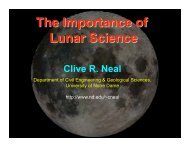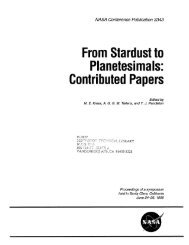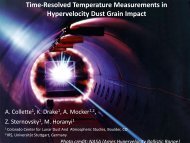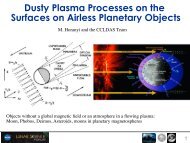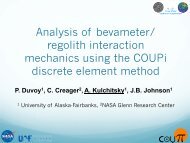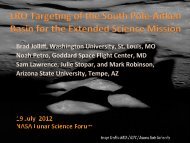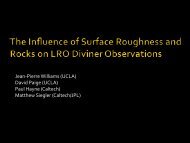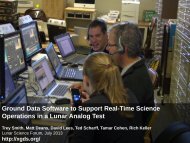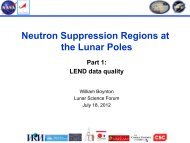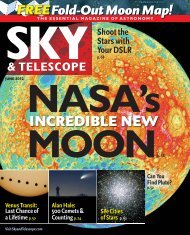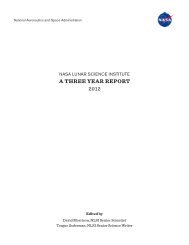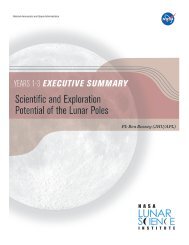A scalable superconductor bearing system for lunar telescopes and ...
A scalable superconductor bearing system for lunar telescopes and ...
A scalable superconductor bearing system for lunar telescopes and ...
Create successful ePaper yourself
Turn your PDF publications into a flip-book with our unique Google optimized e-Paper software.
Building a Prototype Lunar Telescope with<br />
Superconductor<br />
Bearings<br />
Peter C.<br />
Chen<br />
Lightweight<br />
Telescopes, Inc &<br />
Code 671, NASA<br />
GSFC<br />
Douglas M.<br />
Rabin<br />
Code 670, NASA<br />
Goddard Space<br />
Flight Center
2<br />
Abstract<br />
We report on the status of a prototype <strong>lunar</strong><br />
telescope currently under construction. The<br />
telescope, which uses high temperature<br />
<strong>superconductor</strong> <strong>bearing</strong>s, is intended as a tool <strong>for</strong><br />
education <strong>and</strong> public outreach.<br />
Telescopes <strong>and</strong> other pointing instruments on<br />
the Moon require extremely precise pointing<br />
<strong>system</strong>s that can function in the <strong>lunar</strong> environment.<br />
High temperature <strong>superconductor</strong> <strong>bearing</strong>s are<br />
uniquely suited <strong>for</strong> such applications.
Working In The Lunar Environment<br />
3<br />
On the Moon the nights are long (15 days) <strong>and</strong><br />
temperatures range from 100K to 30K inside shadowed craters.<br />
Pointing instruments on the Moon there<strong>for</strong>e require <strong>bearing</strong><br />
<strong>system</strong>s that can position <strong>and</strong> track precisely over long time<br />
periods, with no maintenance <strong>and</strong> do not fail with loss of power.<br />
Normal mechanical <strong>bearing</strong>s <strong>and</strong> lubricants do not<br />
function well under these conditions.<br />
In addition to <strong>telescopes</strong>, many other devices have the<br />
same or similar requirements. These devices range in size<br />
from decimeters (laser communication <strong>system</strong>s) to meters<br />
(communication dishes, optical interferometers, solar panels) to<br />
decameters <strong>and</strong> beyond (VLA type radio interferometers).
High Temperature Superconductor (HTS) Bearings<br />
4<br />
N<br />
magnet<br />
HTS<br />
© P. Chen 2013<br />
Left: Sisters Hannah <strong>and</strong> Sarah Keyes<br />
having fun with levitation <strong>and</strong> flux<br />
pinning of a magnet by a high<br />
temperature <strong>superconductor</strong> (HTS).<br />
A HTS <strong>bearing</strong> consists of a permanent<br />
magnet <strong>and</strong> a high Tc bulk <strong>superconductor</strong>. A<br />
unique phenomenon known as „flux pinning‟<br />
attaches the two together, almost physically<br />
but without contact. The <strong>system</strong> is passive<br />
<strong>and</strong> has no wear. If the magnetic field has<br />
rotational symmetry the magnet can turn<br />
freely about its axis of symmetry. This is the<br />
basis <strong>for</strong> HTS <strong>bearing</strong>s<br />
S
Scaling Problem in a HTS Alt-Az Mount<br />
5<br />
Small<br />
single<br />
magnet<br />
HTS<br />
Tile<br />
Fig. A. Small Bearing System<br />
Fig. B. Large Bearing System<br />
Large<br />
segmented<br />
ring<br />
magnet<br />
HTS<br />
Tiles<br />
It is not practical to use HTS <strong>bearing</strong>s in the customary alt-az<br />
(altitude-azimuth) <strong>and</strong> equatorial mount configurations. The problem is<br />
scaling.<br />
A levitated magnet can spin freely only if the HTS does not sense<br />
any change in field while the magnet rotates (fig. A). For supporting<br />
large loads, large area ring magnets are needed. Large magnets can<br />
only be made in segments (fig. B). The joints between segments<br />
introduce discontinuities in the magnetic field <strong>and</strong> cause cogging <strong>and</strong>/or<br />
jitter in the rotary motion.
Our Idea<br />
Use HTS Bearing with Horizontal Axis of<br />
Rotation<br />
6<br />
A magnet with a horizontal magnetic<br />
axis can rotate freely above a HTS<br />
base<br />
HTS <strong>bearing</strong>s with horizontal<br />
axes can increase load capacity<br />
by joining multiple units on a longer<br />
axle. The process can be extended<br />
indefinitely without introducing<br />
discontinuities in the magnet field.
Available Types of Superconductors<br />
7<br />
Transition Temp (K) Material Class<br />
135 HgBa 2 Ca 2 Cu 3 O x Copper-oxide <strong>superconductor</strong>s<br />
110 Bi 2 Sr 2 Ca 2 Cu 3 O 10 (BSCCO)<br />
92 YBa 2 Cu 3 O 7 (YBCO)<br />
77 Boiling point of Liquid nitrogen<br />
55 SmFeAs(O,F) Iron-based <strong>superconductor</strong>s<br />
41 CeFeAs(O,F)<br />
39 MgB 2<br />
27 SrFe 2 As 1.3 P 0.7<br />
26 LaFeAs(O,F)<br />
20 Boiling point of liquid hydrogen<br />
18 Nb 3 Sn Metallic low-temperature<br />
<strong>superconductor</strong>s<br />
10 NbTi<br />
4.2 Hg (mercury)<br />
For general applications on the Moon, the viable c<strong>and</strong>idate <strong>superconductor</strong>s<br />
are YBCO <strong>and</strong> BSCCO.<br />
Source: http://en.wikipedia.org/wiki/High-temperature_superconductivity,<br />
http://iopscience.iop.org/0953-8984/22/12/125702;jsessionid=68D7F12045778CE2D6032D6F66418F17.c3,<br />
Collins, G. (2009) „An iron key to high-temperature superconductivity‟ Sc. Am. Aug. 62-69
Selection of High Tc Superconductors:<br />
YBCO vs BSCCO<br />
8<br />
Temperature<br />
dependence of F z of<br />
30mm diameter<br />
cylinders of TSMG<br />
YBCO <strong>and</strong> MCP<br />
BSCCO at 5 mm<br />
gap. (Source: Gauss et al. (1999)<br />
„Cryotank with superconducting,<br />
magnetic suspension of the interior<br />
tank‟, IEEE Appl. Supercon. 9, No.2,<br />
June 1999, 1004-1007)<br />
The per<strong>for</strong>mance (in terms of levitation <strong>for</strong>ce) of YBCO is superior to<br />
that of BSCCO at temperatures encountered on the Moon, except<br />
possibly within permanently shadowed craters.
Selection of Magnets:<br />
NdFeB vs SmCo<br />
9<br />
Magnetic Field as<br />
Function of Temperature<br />
<strong>for</strong> NdFeB<br />
<strong>and</strong> SmCo permanent<br />
magnets.<br />
(Source: High <strong>and</strong> Low<br />
Temperature Properties of<br />
Sintered Nd-Fe-B Magnets, K.J.<br />
Strnat, D. Li, <strong>and</strong> H. Mildrum,<br />
Paper no. VIII-8 at the 8 th<br />
International Workshop on Rare<br />
Earth Magnets <strong>and</strong> Their<br />
Applications, Dayton, OH, 6-8<br />
May, 1985)<br />
The strongest magnets available are of two types: neodymium iron<br />
boron (NdFeB) <strong>and</strong> samarium cobalt (SmCo). The figure shows how<br />
their magnetic fields vary as a function of temperature.
Radiation Sensitivity of NdFeB <strong>and</strong> SmCo Magnets<br />
10<br />
It is well known<br />
among physicists<br />
that NdFeB <strong>and</strong><br />
SmCo magnets<br />
differ greatly in<br />
how they are<br />
affected by<br />
radiation. The two<br />
figures show the<br />
effects of neutron<br />
flux (top) <strong>and</strong><br />
proton radiation<br />
(bottom).<br />
Normalized Magnetic Flux<br />
of Permanent Magnets<br />
versus Neutron Flux.<br />
(Source: Liu, J. Vora, P.,<br />
Walmer, M., Chen, C., Talnagi,<br />
J., Wu, S., <strong>and</strong> Harmer, M.<br />
THERMAL STABILITY AND<br />
RADIATION RESISTANCE OF<br />
SM-CO BASED Permanent<br />
Magnets, Proceedings of Space<br />
Nuclear Conference 2007<br />
Boston, Massachusetts, June 24-<br />
28 2007, paper 2036.<br />
Remanence loss in SmCo <strong>and</strong> NdFeB magnets under proton<br />
irradiation. (Source: Y. Sato et. al. (2007) A RADIATION<br />
DAMAGE TEST OF PERMANENT MAGNET MATERIALS FOR<br />
RESIDUAL GAS IONIZATION PROFILE MONITORS.<br />
Proceedings of the4th Annual Meeting of Particle Accelerator<br />
Society of Japan August 1-3, 2007, Wako Japan)
Radiation Environment on the Moon<br />
11<br />
Proton fluence above 10 Mev <strong>and</strong> 30 Mev in solar<br />
flares during three solar cycles. Source: Johnson, C.L.<br />
<strong>and</strong> Dietz, K.L. (1991) Effects of the <strong>lunar</strong> environment<br />
on optical <strong>telescopes</strong> <strong>and</strong> instruments, Proc. SPIE<br />
1494 Space Astronomical Telescopes <strong>and</strong> Instruments<br />
(1991), 208-218.<br />
As shown in the previous slide, SmCo has higher radiation resistance.<br />
However, in the <strong>lunar</strong> environment the level of radiation, in terms of<br />
particle flux <strong>and</strong> particle energy distribution, is below the level where<br />
the difference between NdFeB <strong>and</strong> SmCo becomes significant. YBCO,<br />
with its higher ratio of maximum field strength to mass, is there<strong>for</strong>e the<br />
preferred c<strong>and</strong>idate.
Using HTS Bearings In Large Telescopes<br />
12<br />
A telescope mount that uses <strong>bearing</strong>s with horizontal axes<br />
(„trunion <strong>bearing</strong>s‟) is the altitude-altitude (alt-alt) design. This<br />
concept has been studied in the past, but has not seen much use<br />
because the tracking is in two directions <strong>and</strong> there<strong>for</strong>e impractical<br />
until the advent of computer control. The drawing shown is a design<br />
by Richardson et al. <strong>for</strong> a 8m ground telescope. The four <strong>bearing</strong>s,<br />
which are driven together, are located at the cardinal points E-W-N-S.<br />
Ref: Richardson, E.H., Grundmann, W.A. & Odgers, G.J. (1990) “Altitude-altitude (alt-alt) mounting <strong>for</strong> an 8-metre<br />
telescope”, Proc. SPIE 1236, 896-900.
Optimum Spacing <strong>and</strong> Magnet Field<br />
Configuration in a HTS Bearing<br />
13<br />
A. Construction<br />
of a commercial<br />
HTS <strong>bearing</strong><br />
(Werfer et. al.)<br />
B. Measurement of<br />
the <strong>for</strong>ce between<br />
HTS <strong>and</strong> permanent<br />
magnet as a<br />
function of their<br />
separation distance.<br />
(Werfel et. al.)<br />
Levitation <strong>for</strong>ce in a HTS <strong>bearing</strong> <strong>system</strong> is a function of the magnetic<br />
flux <strong>and</strong> the flux gradient. Maximum <strong>for</strong>ce is obtained in a string of<br />
magnets separated by iron shims (fig. A). (Source: Werfer, F., Floegel, U., Riedel, T.,<br />
Rothfeld, R., Wippich, D. <strong>and</strong> Goebel, B. (2009) HTS Magnetic Bearings in Prototype Application, publ. MT-21-<br />
INV—09-0171(1FO-01), ATZ GmbH, Adelwitz, Germany.
B (tesla)<br />
Lunar HTS Telescope Bearing Detail<br />
14<br />
1<br />
0.5<br />
0<br />
-0.5<br />
-1<br />
Flux along magnet train<br />
1 3 5 7 9 11 13 15 17 19 21 23 25<br />
spacing 0.1 inch interval<br />
S…<br />
© P. Chen 2013<br />
The upper picture shows a foam box (blue) containing a YBCO HTS tile (black<br />
rectangle) <strong>and</strong> one set of <strong>bearing</strong>s. Each <strong>bearing</strong> set consists of four NeFeB<br />
permanent magnets separated by three iron spacers. The chart shows the<br />
variation of B measured by a Hall Probe Magnetometer along its length.
Model Lunar Telescope with Superconductor Bearings<br />
15<br />
© P. Chen 2013<br />
We are building a model telescope with HTS <strong>bearing</strong>s in an altitude-altitude<br />
mounting. The telescope swings up <strong>and</strong> down on two <strong>bearing</strong>s on its sides<br />
(vertical in the picture). It moves side-to-side on two <strong>bearing</strong>s (horizontal in the<br />
picture) located at the front <strong>and</strong> rear.
Model Lunar HTS Telescope Levitated On Upper Stage<br />
16<br />
© P. Chen 2013<br />
Shown above is the Questar® telescope being levitated on one<br />
set of its <strong>bearing</strong>s. This is the upper stage <strong>bearing</strong> which permits<br />
the telescope to point up <strong>and</strong> down.
Model Lunar HTS Telescope Levitated On Lower Stage<br />
17<br />
© P. Chen 2013<br />
The picture shows the Questar® telescope being levitated on the other set of<br />
its <strong>bearing</strong>s. This is the lower stage <strong>bearing</strong> which permits the telescope <strong>and</strong><br />
the structure holding it to swing from side to side.
18<br />
© P. Chen 2013<br />
Artist‟s concept of a large telescope on the Moon using HTS <strong>bearing</strong>s<br />
Background: NHK TV Japan. Artwork by Alan Chen (RPI) <strong>and</strong> Heather Chen (St. Mary‟s College MD)
19<br />
Work In Progress<br />
Work is currently under way in the following areas:<br />
1. The HTS <strong>bearing</strong> is essentially frictionless. Fine<br />
adjustment mechanisms are being designed <strong>and</strong><br />
incorporated so that components of the telescope<br />
can be precisely positioned <strong>and</strong> balanced.<br />
2. A non-contact drive <strong>system</strong> is being designed that<br />
can move the telescope without making physical<br />
contact.<br />
3. Advanced CAD (computer aided design) tools are<br />
being used to design <strong>and</strong> build an improved<br />
model.
Acknowledgements<br />
We thank G. Canter. C. Cursey, P. Mirel, T.<br />
Plummer, M. Perry, T. Perry, M. Saulino, <strong>and</strong> A.<br />
Weston (NASA GSFC) <strong>for</strong> advice <strong>and</strong> assistance.<br />
G. Au (Atholton HS, Columbia MD) <strong>and</strong> E.<br />
Chen (Shore Country Day School, Beverly MA)<br />
assisted in the design, construction, <strong>and</strong> testing of<br />
the model telescope.<br />
This work was supported under grant<br />
NNA09DB30A from the Lunar University Network<br />
<strong>for</strong> Astrophysics Research (LUNAR), a consortium<br />
of research institutions led by the University of<br />
Colorado, Dr. J. Burns, PI.



